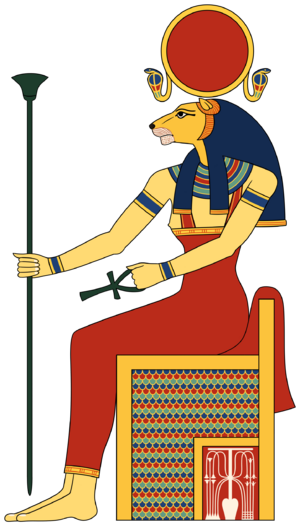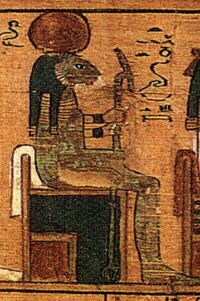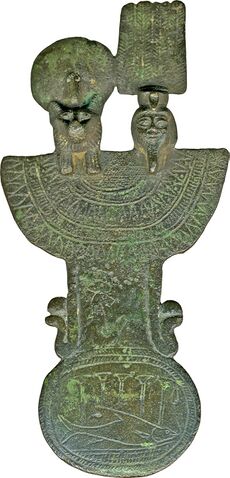تفنوت
| تفنوت | |||||
|---|---|---|---|---|---|
إلهة الرطوبة | |||||
 الإلهة تفنوت مُصوَّرة كإمرأة برأس لبؤة ويستقر قرص الشمس فوق رأسها. | |||||
| الاسم بالهيروغليفية |
| ||||
| مركز العبادة الرئيسي | أون، ليونتوپوليس | ||||
| الرمز | لبؤة، قرص الشمس | ||||
| معلومات شخصية | |||||
| الأبوان | رع-أتوم وIusaaset | ||||
| الأشقاء | شو، حتحور، ماعت، Anhur، سخمت، باستت، Mafdet, Satet | ||||
| القرين | شو، گب | ||||
| الأنجال | گب و نوت | ||||
تفنوت ( Tefnut ، Ancient Egyptian: tfn.t؛ Coptic: ⲧϥⲏⲛⲉ tfēne)[1][2] هي أحد الآلهة المصرية القديمة، تمثل آلهة تفنوت عنصر المياه والرطوبة والندى والمطر، وترتبط بأشعة الشمس والقمر.[3]
كانت هي وأخيها وزجها "شو" أولى المخلوقات التي خلفها "أتوم" من ذاته وحيداً، وهما يمثلان عينا "حورس" رمز الشمس والقمر .[4] وهي والدة گب ونوت.
أصل الاسم
The name Tefnut has no certain etymology but it may be an onomatopoeia of the sound of spitting, as Atum spits her out in some versions of the creation myth. Additionally, her name was written as a mouth spitting in late texts.[5]
Like most Egyptian deities, including her brother, Tefnut has no single ideograph or symbol. Her name in hieroglyphs consists of four single phonogram signs t-f-n-t. Although the n phonogram is a representation of waves on the surface of water, it was never used as an ideogram or determinative for the word water (mw), or for anything associated with water.[6]
وصف الرمز
كثيرا ما تصور الآلهة المصرية كجزء إنسان وجزء حيوان، لأن في الديانة القديمة بعض الحيوانات كانت تعتبر مقدسة للاعتقاد بأن روح الله تسكن هذه الحيوانات مثل اللبؤة أو الأسد، والتي تمنح الاله التبجيل ليعبد كما أن جسده يمنحة الحياة الأبدية. فكانت تفنوت جسد امرأة شابة، ورأس لبؤة أو الأسد[7] توحدت مع أخيها وزوجها شو لتكون التوأم الأسد.
الأصول الأسطورية
|
جزء من سلسلة مقالات عن |

|
|
المعتقدات الرئيسية
وثنية • وحدة الوجود • تعدد الآلهة |
| الشعائر |
| صيغة التقديم • الجنائز • المعابد |
| الآلهة |
| أمون • أمونت • أنوبيس • أنوكت أپپ • أپيس • آتن • أتوم باستت • بات • بس أبناء حورس الأربعة گب • هاپي • حتحور • حقت حورس • إيزيس • خپري • خنوم خونسو • كوك • معحص • ماعت معفدت • منحيت • مرت سگر مسخنت • مونتو • مين • مر-ور موت • نون • نيت • نخبت نفتيس • نوت • اوزيريس • پاخت پتاح • رع • رع-حوراختي • رشپ ساتيس • سخمت • سكر • سركت سوبك • سوپدو • ست • سشات • شو تاورت • تفنوت • تحوت واجت • واج-ور • وپواوت • وسرت |
| النـصـوص |
| عمدوعت • كتاب التنفس كتاب المغارات • كتاب الموتى كتاب الأرض • كتاب الأبواب كتاب العالم السفلي |
| غيرهم |
| الآتونية • لعنة الفراعنة |
تم خلق الإلهة تفنوت بواسطة أتون إله الشمس رع الذي كون عنصر الرطوبة الممثلة في تفنوت وعنصر الهواء الممثل في أخيها وزوجها شو وقد طور الكهنة المصريون الأوائل أسطورة بدء الخلق أو نشأة الكون وذلك لتفسير وشرح كيفية خروج بعض الآلهة لحيز الوجود ممثلين لجميع العناصر المادية والمعنويةالتي تشمل الصفات الحسنة والصفات السيئة المحيطة بالبشر، فالكهنة الأوائل طورو شجرة العائلة والأقارب الخاصة بالآلهة الرئيسية.
فشو إله الهواء مع شقيقته التوأم تفنوت إلهة الماء وذريتهم (إله الأرض ، وآلهة السماء )والأربعة يتألف منهم العناصر الرئيسية في الحياه :الأرض والهواء والسماء والماء ، فقد اعتقد المصريون القدماء أن الارض بدون ماء يمكن أن تجف وتحرقها حرارة الشمس.
Tefnut is a daughter of the solar deity Ra-Atum. Married to her twin brother Shu, she is mother of Nut, the sky and Geb, the earth. Tefnut's grandchildren were Osiris, Isis, Set, Nephthys, and, in some versions, Horus the Elder. She was also the great-grandmother of Horus the Younger. Alongside her father, brother, children, grandchildren, and great-grandchild، وهي عضو في تاسوع أون.
There are a number of variants to the myth of the creation of the twins Tefnut and Shu. In every version, Tefnut is the product of parthenogenesis, and all involve some variety of body fluid.
In the Heliopolitan creation myth, Atum sneezed to produce Tefnut and Shu.[8] Pyramid Text 527 says, "Atum was creative in that he proceeded to sneeze while in Heliopolis. And brother and sister were born - that is Shu and Tefnut."[9]
In some versions of this myth, Atum also spits out his saliva, which forms the act of procreation. This version contains a play on words, the tef sound which forms the first syllable of the name Tefnut also constitutes a word meaning "to spit" or "to expectorate".[9]
The Coffin Texts contain references to Shu being sneezed out by Atum from his nose, and Tefnut being spat out like saliva. The Bremner-Rind Papyrus and the Memphite Theology describe Atum as sneezing out saliva to form the twins.[10]
التصوير
Tefnut is a leonine deity, and appears as human with a lioness head when depicted as part of the Great Ennead of Heliopolis. The other frequent depiction is as a lioness, but Tefnut can also be depicted as fully human. In her fully or semi anthropomorphic form, she is depicted wearing a wig, topped either with a uraeus serpent, or a uraeus and solar disk, and she is sometimes depicted as a lion headed serpent. Her face is sometimes used in a double headed form with that of her brother Shu on collar counterpoises.[11]
During the 18th and 19th Dynasties, particularly during the Amarna Period, Tefnut was depicted in human form wearing a low flat headdress, topped with sprouting plants. Akhenaten's mother, Tiye was depicted wearing a similar headdress, and identifying with Hathor-Tefnut. The iconic blue crown of Nefertiti is thought by archaeologist Joyce Tyldesley to be derived from Tiye's headdress, and may indicate that she was also identifying with Tefnut.[12]
مراكز العبادة
Heliopolis and Leontopolis (now ell el-Muqdam) were the primary cult centres. At Heliopolis, Tefnut was one of the members of that city's great Ennead,[11] and is referred to in relation to the purification of the wabet (priest) as part of the temple rite. Here she had a sanctuary called the Lower Menset.[3]
I have ascended to you
with the Great One behind me
and [my] purity before me:
I have passed by Tefnut,
even while Tefnut was purifying me,
and indeed I am a priest, the son of a priest in this temple."
At Karnak, Tefnut formed part of the Ennead and was invoked in prayers for the health and wellbeing of the pharaoh.[14]
She was worshiped with Shu as a pair of lions in Leontopolis in the Nile Delta.[15]
معبد تفنوت
قبل دخول المعبد يسمح للفرعون والكهنة فقط بالقاء حجر في بركة عميقة قبل دخولهم الحرم الداخلي للمعبد لبدء طقوس العبادة ، كنوع من التطهير لهم ويسمح للمصريين العاديين أن يأتي لأبواب أو مقدمة ساحة المعبد للتبرك وتقديم الهدايا.
أما في داخل المعبد فنجد الهيكل يتألف من بوابات ثقيلة تؤدي لقاعة ضخمة على جوانبها أعمدة حجرية كبيرة ، وبعد ذلك سلسلة من الغرف وهذه الغرف أو الدوائر يتم إشعال الشموع والبخور فيها لتنقية هواء المعبد ، اما الإضاءة في المعبد والغرف في منخفضة إلى حد كبير لخلق جو عميق من الغموض ويوجد بالمعبد ضريح بداخله حجر يضم تمثال كبير لآلهة المطر.
تمثال تفنوت
يوجد تمثال كبير في الحرم الداخلي للمعبد ، ولهذا التمثال المقدس كاهن خاص يقوم بإجراء مراسم الصلوات والطلاسم ، كما يوجد كاهن آخر مسؤولا عن نظافة التمثال وتاهيله وغسله ، ثم يرتدي التمثال البوص يضع له مكياج العين ومسحوق على الشفتين وطبقات من الزيت المقدس يفرك على جبين التمثال ، ويحتفل المصريين العاديين به في المهرجانات والاعياد بمواكب رائعة.
كان مركز عبادتهما في مدينة "ليونتوبوليس" بالدلتا .
الأساطير
Tefnut was connected with other leonine goddesses as the Eye of Ra.[16] As a lioness she could display a wrathful aspect and is said to have escaped to Nubia in a rage, jealous of her grandchildren's higher worship. Only after receiving the title "honorable" from Thoth, did she return.[5] In the earlier Pyramid Texts she is said to produce pure waters from her vagina.[17]
As Shu had forcibly separated his son Geb from his sister-wife Nut, Geb challenged his father Shu, causing the latter to withdraw from the world. Geb, who was in love with his mother Tefnut, takes her as his chief queen-consort.[18]
المصادر
- ^ "Tfn.t (Lemma ID 171880)". Thesaurus Linguae Aegyptiae.
- ^ Love, Edward O. D. (2021). "Innovative Scripts and Spellings at Narmoute/Narmouthis". Script Switching in Roman Egypt. de Gruyter. p. 312. doi:10.1515/9783110768435-014. ISBN 9783110768435. S2CID 245076169.
- ^ أ ب The Routledge Dictionary of Egyptian Gods and Goddesses, George Hart ISBN 0-415-34495-6
- ^ الإلهة تفنوت
- ^ أ ب Wilkinson, Richard H. (2003). The Complete Gods and Goddesses of Ancient Egypt. London: Thames & Hudson. p. 183. ISBN 0-500-05120-8. Retrieved 4 May 2022.
- ^ Betro, Maria Carmela (1996). Hieroglyphics: The Writings of Ancient Egypt (in الإنجليزية). Abbeville Press. pp. 163. ISBN 0-7892-0232-8.
- ^ معلومات عن الإلهة تفنوت
- ^ Hassan, Fekri A (1998). "5". In Goodison, Lucy; Morris, Christine (eds.). Ancient Goddesses. London: British Museum Press. p. 107. ISBN 0-7141-1761-7.
- ^ أ ب Watterson, Barbara (2003). Gods of Ancient Egypt. Sutton Publishing. p. 27. ISBN 0-7509-3262-7.
- ^ Pinch, Geraldine (2002). Handbook of Egyptian Mythology. ABC-CLIO. p. 63. ISBN 978-1-57607-242-4.
- ^ أ ب Wilkinson, Richard H (2003). The Complete Gods and Goddesses of Ancient Egypt. Thames & Hudson. pp. 183. ISBN 0-500-05120-8.
- ^ Tyldesley, Joyce (2005). Nefertiti: Egypt's Sun Queen (2nd ed.). Penguin UK. ISBN 978-0140258202. Retrieved 17 January 2016.
- ^ Hays, H.M (2009). Nyord R, Kyolby A (ed.). "Between Identity and Agency in Ancient Egyptian Ritual". Leiden University Repository: Archaeopress: 15–30. hdl:1887/15716.
Rite 25 from Moret, Le Rituel de Cult, Paris 1902
{{cite journal}}: Cite journal requires|journal=(help) - ^ Meeks, Dimitri; Christine Favard-Meeks (1999). Daily Life of the Egyptian Gods (in الإنجليزية). Pimlico. p. 128. ISBN 0-7126-6515-3.
- ^ The Routledge Dictionary of Egyptian Gods and Goddesses, George Hart ISBN 0-415-34495-6,
- ^ Watterson, Barbara (2003). Gods of Ancient Egypt. Sutton Publishing. ISBN 0-7509-3262-7.
- ^ The Ancient Egyptian Pyramid Texts, trans R.O. Faulkner, line 2065 Utt. 685.
- ^ Pinch, Geraldine (2002). Handbook of Egyptian Mythology. ABC-CLIO. p. 76. ISBN 1576072428.
وصلات خارجية
 Media related to تفنوت at Wikimedia Commons
Media related to تفنوت at Wikimedia Commons
- Short description is different from Wikidata
- Articles having different image on Wikidata and Wikipedia
- Articles containing Ancient Egyptian-language text
- Pages using Lang-xx templates
- Articles with hatnote templates targeting a nonexistent page
- إلهات مصرية
- إلهات خصوبة
- Wind goddesses
- Water goddesses
- Rain deities
- Animal goddesses
- Personifications
- Lion goddesses
- Mythological rape victims
- إلهات بحر ونهر

